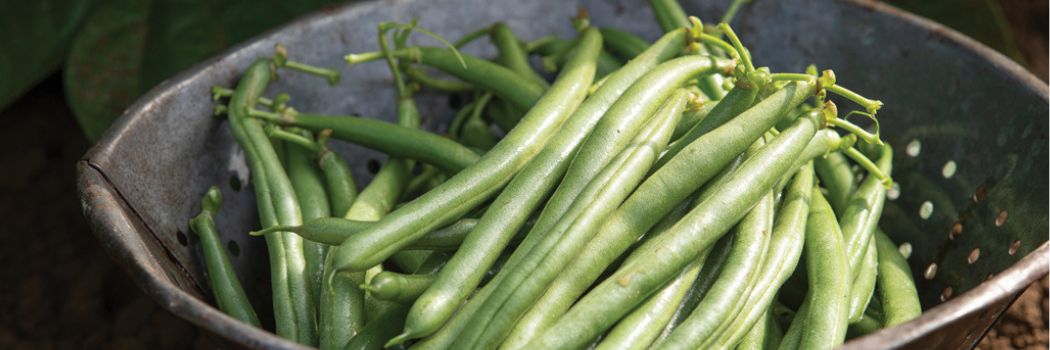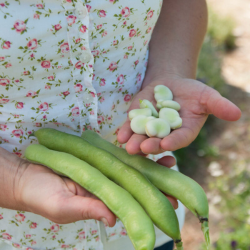- Types of Beans | Bean Basics From Johnny's Selected Seeds
- Video: How to Grow Bush Beans • From Seed to Harvest
- Video: High-Value Crops & Varieties for Your Garden • Tutorial with Niki Jabbour
- Bean FAQs
- Lima Bean | Key Growing Information
- Pole Bean | Key Growing Information
- Bush Beans | Key Growing Information
- French Filet Beans | Key Growing Information
- About Snap, String & Green Beans | Johnny's Selected Seeds
- Fava Bean | Key Growing Information
- Soybean | Key Growing Information
- About Pole Beans | 4 Steps to Success: Select Varieties, Plant Seed & Set Up Your Trellis
- Bush Bean Varieties | Comparison Chart (PDF)
- Fresh Shell Beans | Key Growing Information
- How to Grow Pole Beans • From Seed to Harvest
"What shall I learn of beans or beans of me?"
Beans are a mainstay of the summer vegetable garden, and a standard at every farmstand. They are an easy-to-grow, multiuse crop with many types and varieties available.
Introductions from bean breeders in recent years offer greater color, yield and, importantly, disease resistance—but best of all, the eating quality of our bean offerings today is better than ever.
"I came to love my rows, my beans, though so many more than I wanted. They attached me to the earth, and so I got strength like Antæus. But why should I raise them? Only Heaven knows. This was my curious labor all summer… What shall I learn of beans or beans of me? I cherish them, I hoe them, early and late I have an eye to them; and this is my day's work. It is a fine broad leaf to look on."
–H.D. Thoreau, Walden
One of the most nutrient-dense of all foods, beans are a dietary staple around the world, and deeply rooted in our culinary traditions since ancient times.
In short, we cannot imagine life—even, for many of us, a single growing season—without beans.
Main Types of Beans: How They Grow & When We Eat Them
View all our bean varieties…
Because of their tremendous diversity, beans can be categorized in many different ways. Here are two convenient ways to divide them up.
First, on the basis of their plant habit:
- Bush Beans are mounding types that are low-growing, with a compact plant habit, usually growing to about 1–2 feet high.
- Pole Beans are runner or vining types that can grow very tall, typically requiring some form of trellising.
Second, according to the stage at which they're eaten:
- Snap Beans aka String Beans are eaten fresh, pod and all.
- Fresh Shell Beans are intended to be eaten when the seeds are still young, just full-sized and sweet and starchy, before they start to dry down.
- Dry Beans are eaten after the seeds in the pod have matured and dried out. Shell beans can be allowed to dry on the plant to become dry beans.
Shell Bean to Dry Bean
Flambo is an example of a multi-purpose fresh shell bean that offers excellent eating quality both when picked early, at the fresh-shell-bean stage, and later at the dry-bean stage. It is easier to shell than the typical Lima bean and is firm and flavorful.
Another shell-to-dry-bean is the Italian cannellini, which is a large, white kidney-shaped bean variety that offers excellent eating quality both when picked early, at the shell-bean stage, and at the dry-bean stage. Slightly nutty with mild earthiness, this bean is relatively thin-skinned, with tender creamy flesh that holds its shape well—a superb choice for traditional dishes such as minestrone, ragoûts, and pasta y fagioli.
And More Beans : Common Subtypes
Here are some definitions and additional details regarding common subtypes of beans.
Snap Beans
Snap beans include both bush bean types and pole beans. They are eaten pod and all, when immature, while the pods still have some "snap" to them. Some snap beans are also known as string beans and green beans, but they are not always stringy anymore, thanks to recent breeding developments, and not always green, but may have green or purple pods. (To compare the bushy, mounding types of snap beans, see our Bush Bean Comparison Chart.)Filet Beans
Commonly grown in France and widely known as haricots verts, filet beans are a subgroup of bush snap beans harvested when young and succulent. Reaching peak flavor at ⅛–¼-inch diameter, they are prized for their slender pods with a crisp, yet delicate texture. Filet beans are also known as fine beans by the British, and are regarded as a fancy, gourmet, or specialty produce item. While they do require frequent picking to maintain a continuous yield of extra-fine-grade pods, they are not otherwise difficult to grow.Wax Beans
Wax beans are snap beans—bush or pole—with pods that are yellow in color, including those that are yellow variegated with purple, and with a matte or satiny finish and a faint waxiness to the texture.Soybeans
Soybeans are fresh shell and dry beans of the native East Asian species Glycine max. Also known as soja beans and soyabeans, they are consumed worldwide and highly regarded for their yield, protein, and oil content, plus a multitude of uses—including green and dry cooking, flour, soy milk, tofu, soy sauce, and miso. Our selection is focused on early-maturing, vegetable types.
Some Lesser-Known Bean Types
Fava Beans (a.k.a. broad beans)
The only bean that likes cool weather, fava beans are suited at higher latitudes to early-spring plantings for early-summer crops and late-summer plantings for fall crops. In milder areas, fall plantings can be made to produce spring crops. Also known as broad beans, favas are good both as fresh shell and dry beans. 'Vroma' is sturdy, less prone to lodging, and more heat tolerant than other favas.Lima Beans
Lima beans are a different species (Phaseolus lunatus) from snap beans (Phaseolus vulgaris). Because they need warm soil to germinate and a long, hot summer to produce good crops, lima beans grow best in hotter regions. Given adequate warmth and protection for enough time, however, they will perform at more temperate latitudes. The early-maturing 'Fordhook 242' is our standard all-time favorite. Tip: The smaller types of baby limas that grow particularly well in the South are often referred to as butter beans.Edamame
These are soybean varieties bred to be consumed at the green shell stage, when the seeds are just full-sized, before they become starchy and begin to dry down. Typically boiled or steamed, edamame are often served sprinkled with sea salt, in the pod. Long popular in East Asia, edamame are commonly served nowadays in stateside Asian restaurants.




